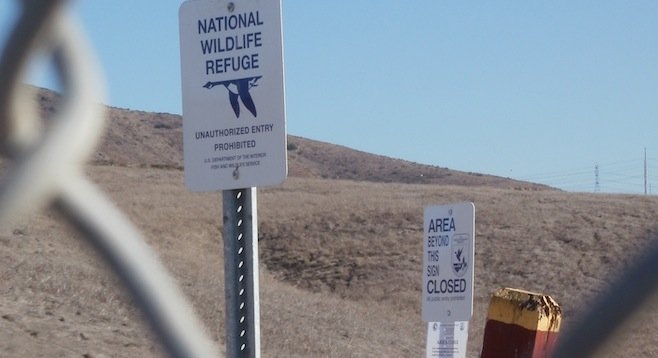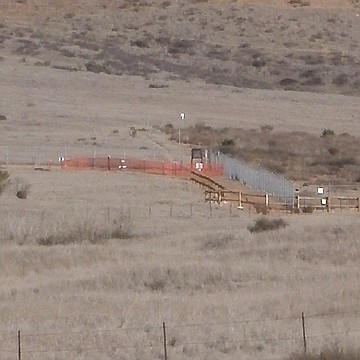 Facebook
Facebook
 X
X
 Instagram
Instagram
 TikTok
TikTok
 Youtube
Youtube

The county and the Sweetwater Authority are still trying to figure out which agency is going to be responsible for moving a closed trail around a newly discovered patch of fairy shrimp, an endangered species.
"It's paralysis by analysis," says Diane Carter, president of the Bonita Valley Horsemen. "Everyone says they want to do the right thing — they have filled out the permit application, but the delay is over who will sign it."

The permit became necessary in November, when the U.S. Fish & Wildlife Service notified the water authority and the county that dormant fairy shrimp had been found in tire ruts on a trail in Sweetwater Regional Park. The South Side trail — which follows the southern edge of the park, continues east over the mountains, and eventually reaches Jamul — was closed within days.
Mountain bikers, hikers, and equestrians who use the trail met with water authority and county officials on December 3 and discovered that the agencies, like the users, had no say in the closure.
At the meeting, the public presented ways to avoid the fairy shrimp, including building a low boardwalk and rerouting the trail around the endangered critters. Notice that the trail was closed went out December 11. Complicating matters, the trail is on land owned by the water authority but licensed to the county for its park. Now the county and the water authority have gotten stuck in discussions about who should sign the permit application for a short-term solution.
The permit will be issued by U.S. Fish & Wildlife 30 days after it is published in the federal register — which means that work can't even begin for more than a month.
According to a January 8 letter from the county to the water authority, the county is worried that signing the permit will make it accountable to the feds, even though the county lacks the ownership rights to do construction and enforcement on the property. The letter suggests other options, "such as Sweetwater Authority's deeding the trail to the county, granting the County a trail easement, or leasing the trail to the county."
It also raises concerns.
"We hope Sweetwater Authority will not use the time needed to negotiate a long-term solution as a delay tactic to hold up the process, causing a collateral impact to the public," the letter states.
At the December 3 meeting, water-authority manager Jim Smyth said that there's limited funding for things that aren't part of the water-delivery business. He reminded people that the money would come from the authority's ratepayers.
On Friday, January 17, Smyth said that he is going to have to take the issue to the water-authority board, which next meets on January 22. (The trail problem does not appear to be on the board agenda.)
"It gets into ownership," he said. "Anytime you're dealing with water, you have three layers of bureaucracy."


The county and the Sweetwater Authority are still trying to figure out which agency is going to be responsible for moving a closed trail around a newly discovered patch of fairy shrimp, an endangered species.
"It's paralysis by analysis," says Diane Carter, president of the Bonita Valley Horsemen. "Everyone says they want to do the right thing — they have filled out the permit application, but the delay is over who will sign it."

The permit became necessary in November, when the U.S. Fish & Wildlife Service notified the water authority and the county that dormant fairy shrimp had been found in tire ruts on a trail in Sweetwater Regional Park. The South Side trail — which follows the southern edge of the park, continues east over the mountains, and eventually reaches Jamul — was closed within days.
Mountain bikers, hikers, and equestrians who use the trail met with water authority and county officials on December 3 and discovered that the agencies, like the users, had no say in the closure.
At the meeting, the public presented ways to avoid the fairy shrimp, including building a low boardwalk and rerouting the trail around the endangered critters. Notice that the trail was closed went out December 11. Complicating matters, the trail is on land owned by the water authority but licensed to the county for its park. Now the county and the water authority have gotten stuck in discussions about who should sign the permit application for a short-term solution.
The permit will be issued by U.S. Fish & Wildlife 30 days after it is published in the federal register — which means that work can't even begin for more than a month.
According to a January 8 letter from the county to the water authority, the county is worried that signing the permit will make it accountable to the feds, even though the county lacks the ownership rights to do construction and enforcement on the property. The letter suggests other options, "such as Sweetwater Authority's deeding the trail to the county, granting the County a trail easement, or leasing the trail to the county."
It also raises concerns.
"We hope Sweetwater Authority will not use the time needed to negotiate a long-term solution as a delay tactic to hold up the process, causing a collateral impact to the public," the letter states.
At the December 3 meeting, water-authority manager Jim Smyth said that there's limited funding for things that aren't part of the water-delivery business. He reminded people that the money would come from the authority's ratepayers.
On Friday, January 17, Smyth said that he is going to have to take the issue to the water-authority board, which next meets on January 22. (The trail problem does not appear to be on the board agenda.)
"It gets into ownership," he said. "Anytime you're dealing with water, you have three layers of bureaucracy."
Comments